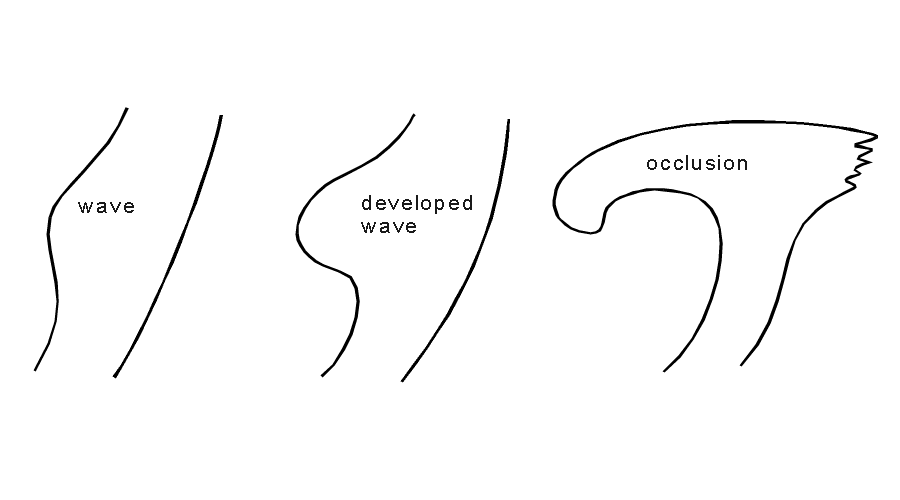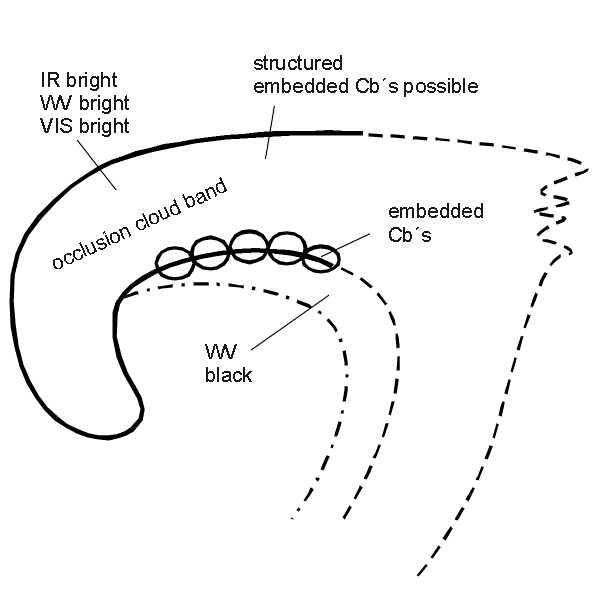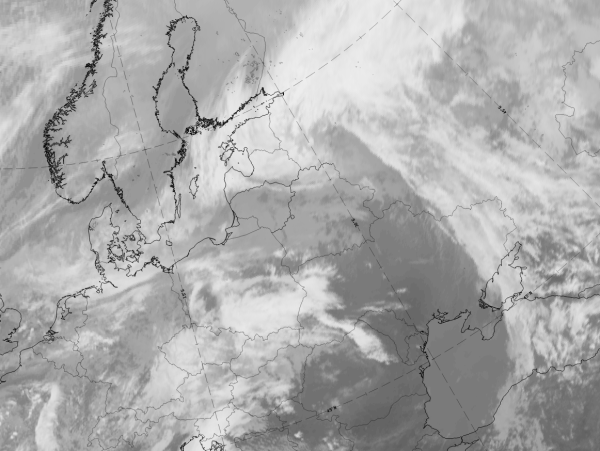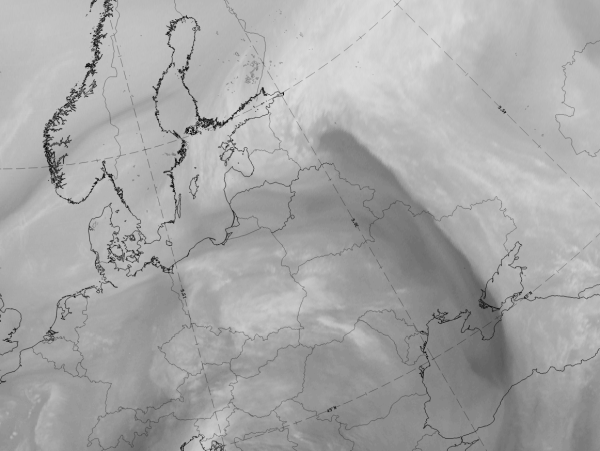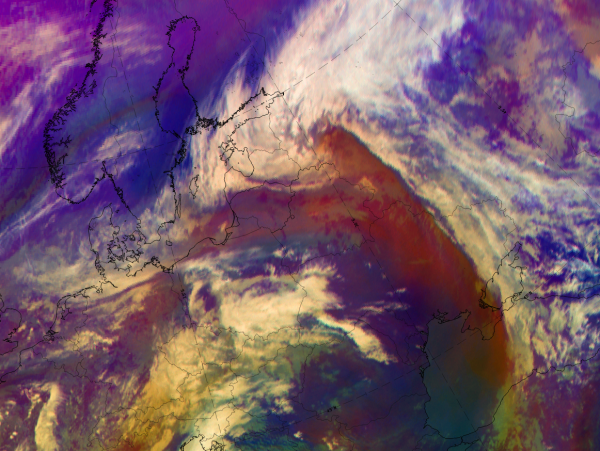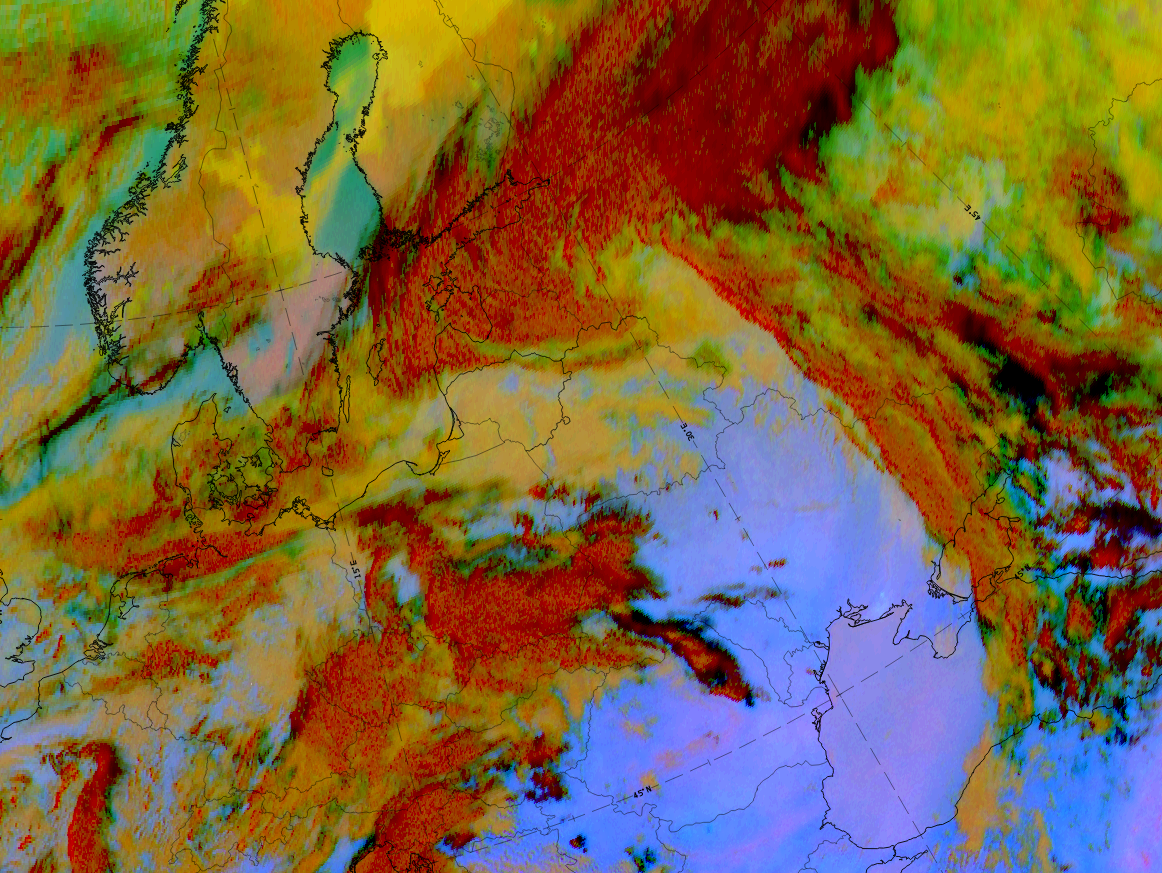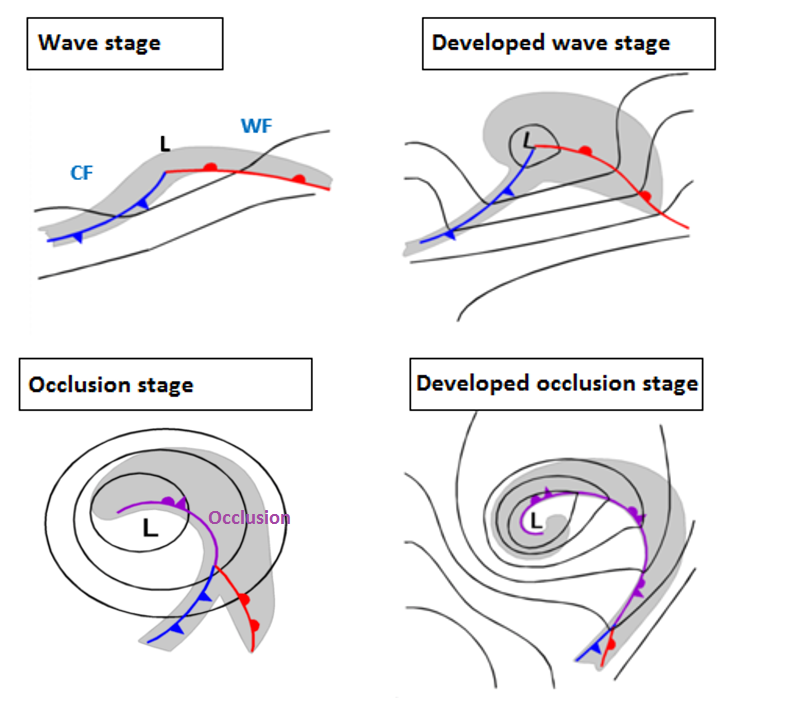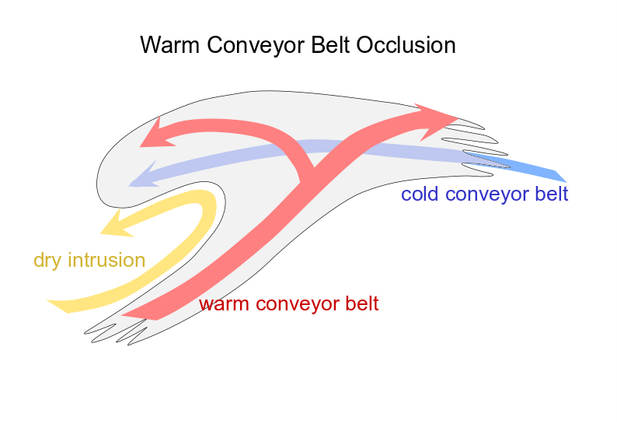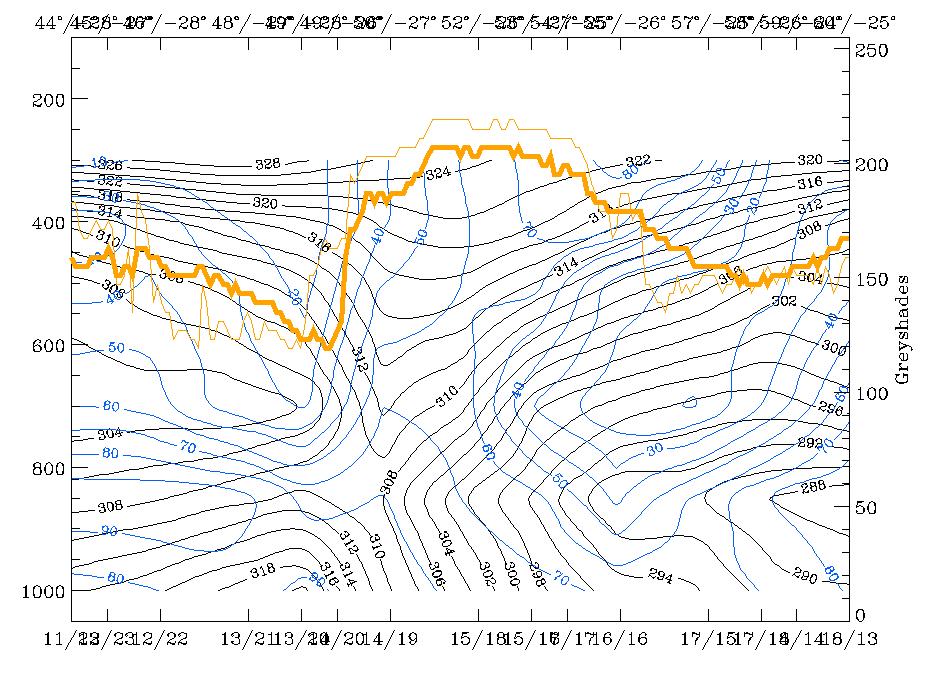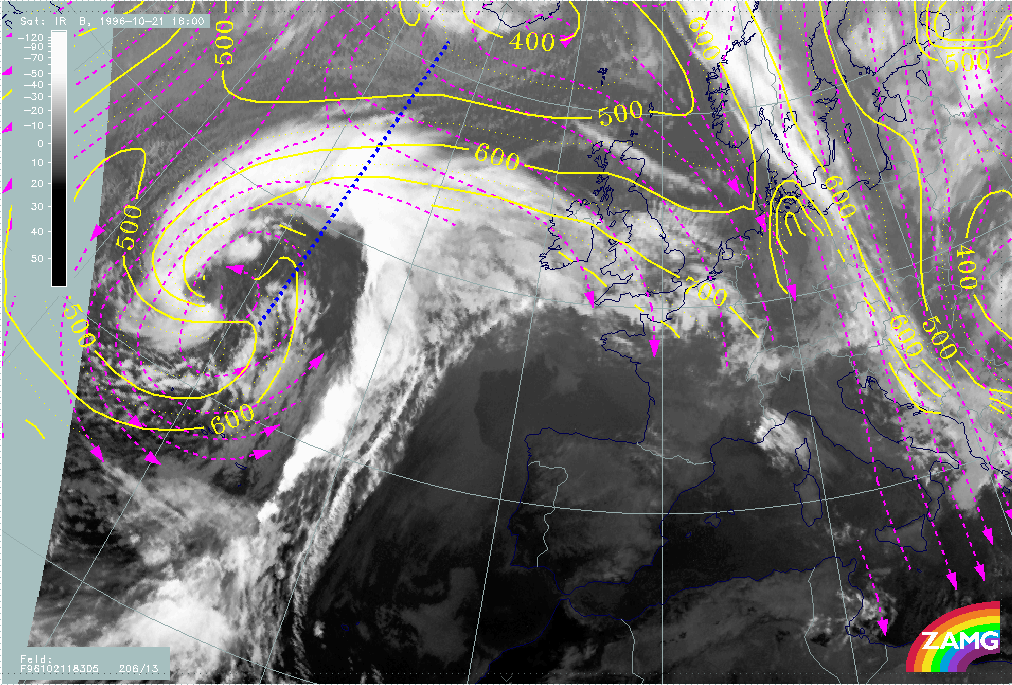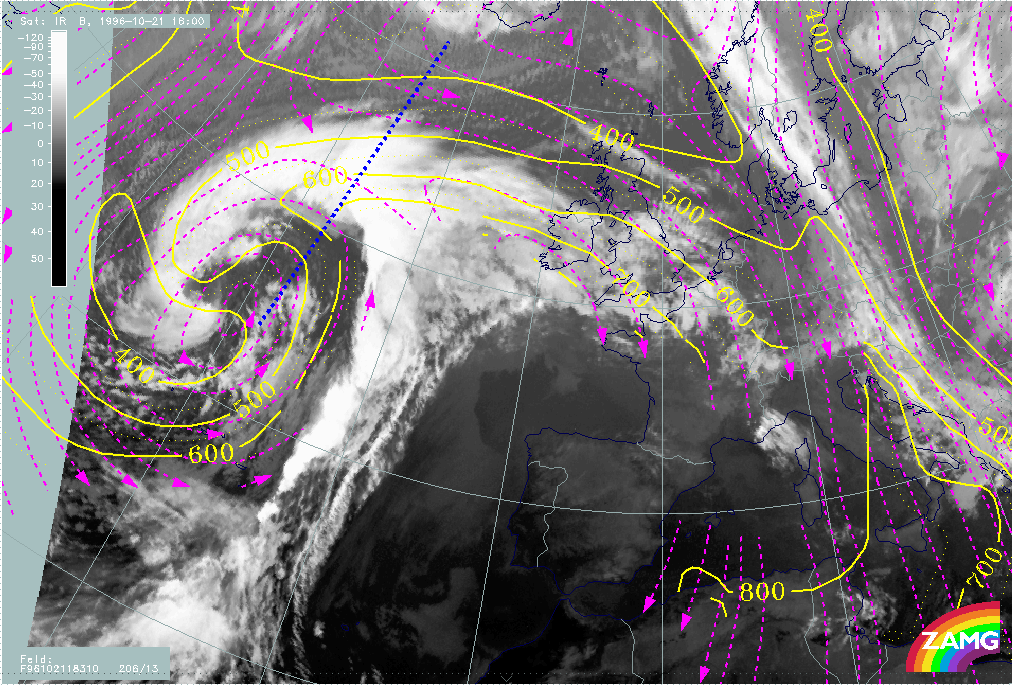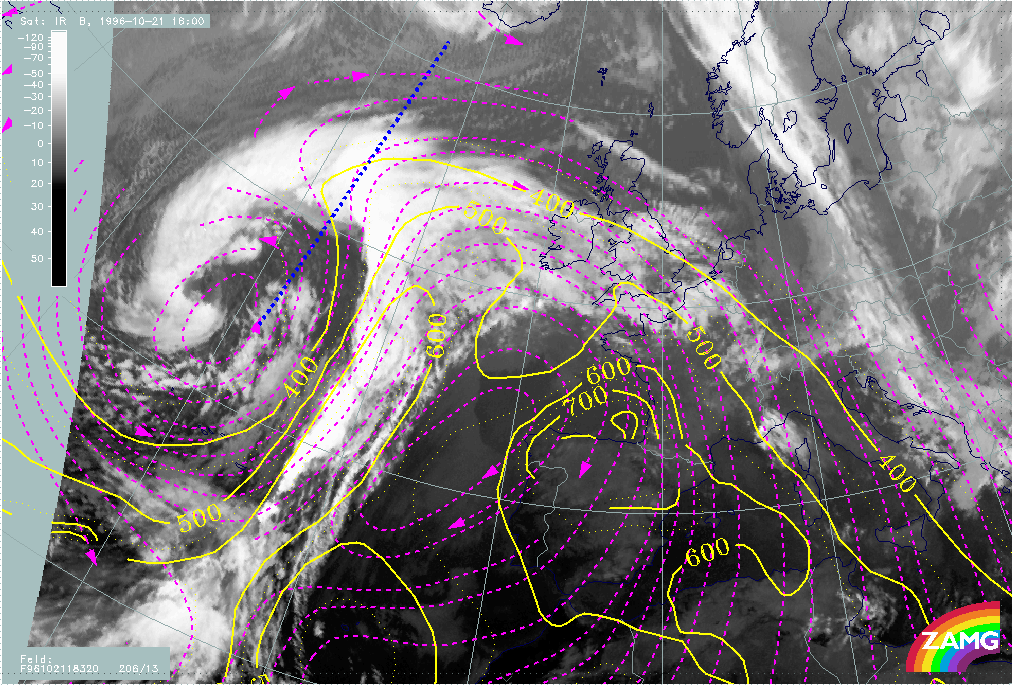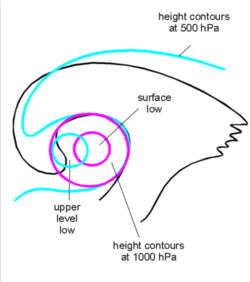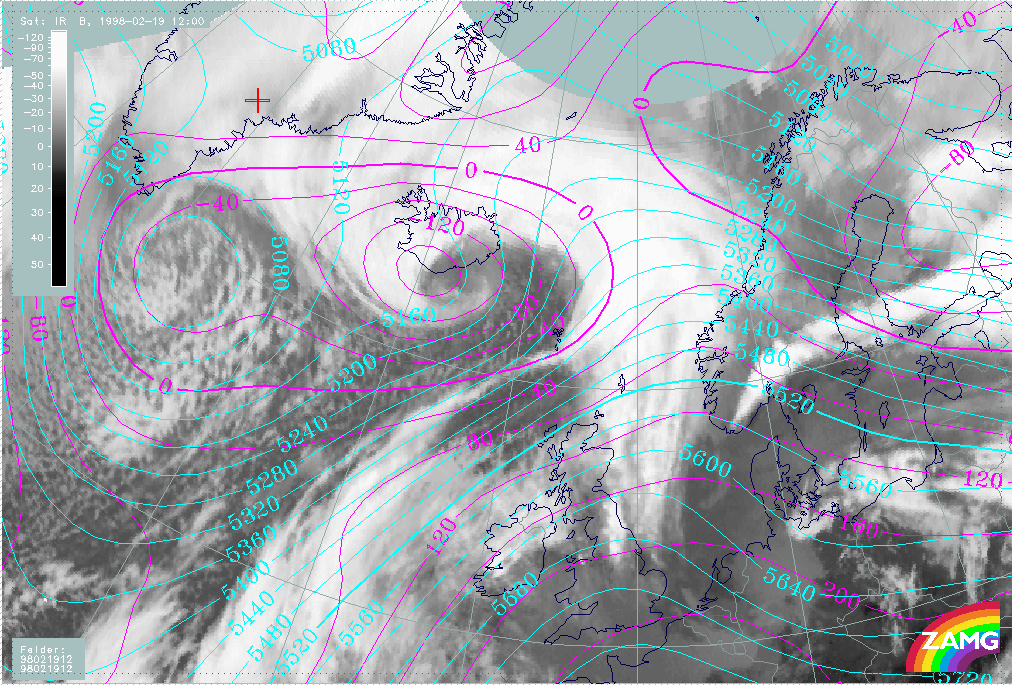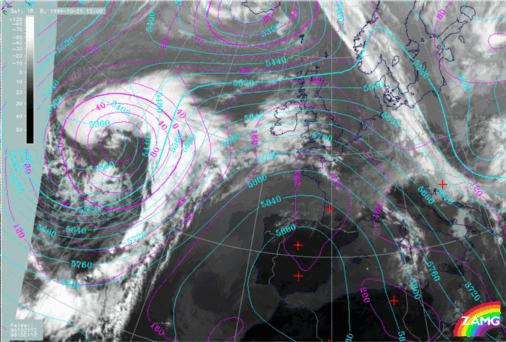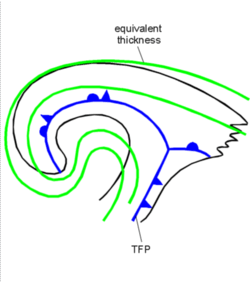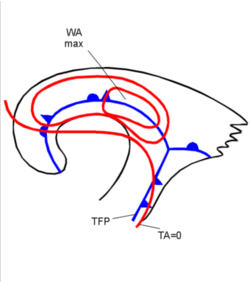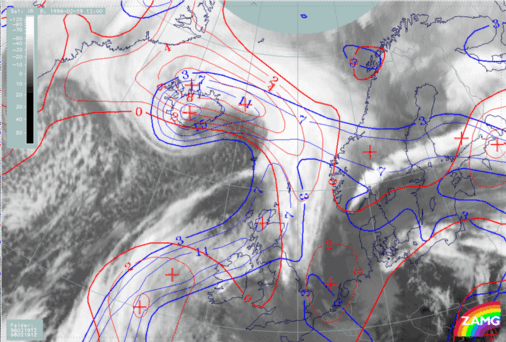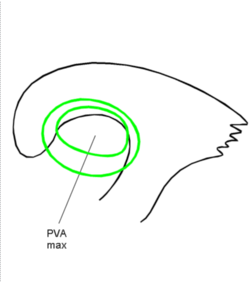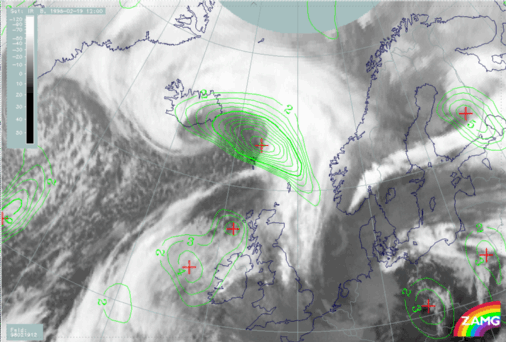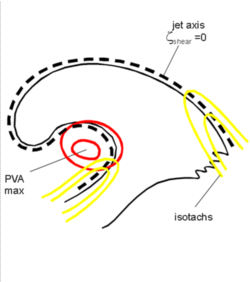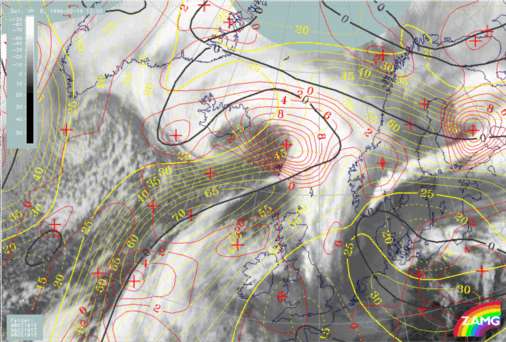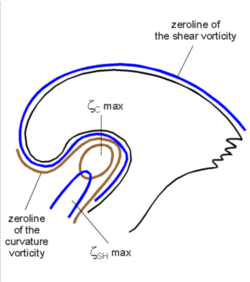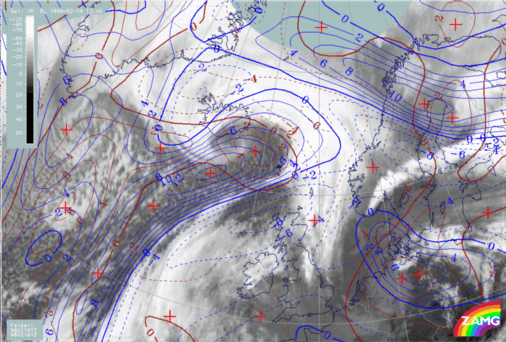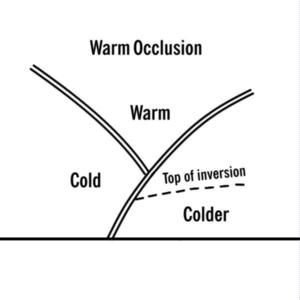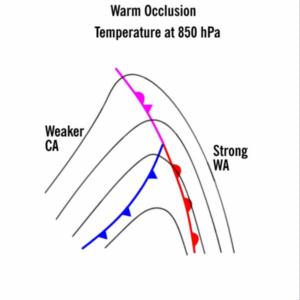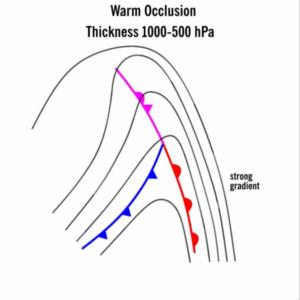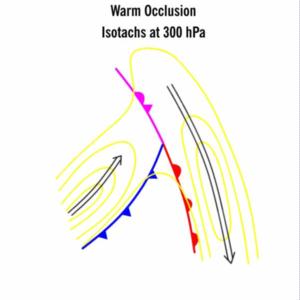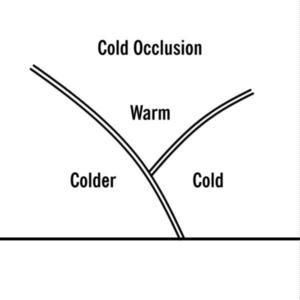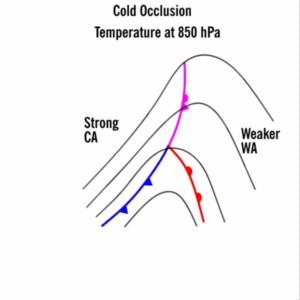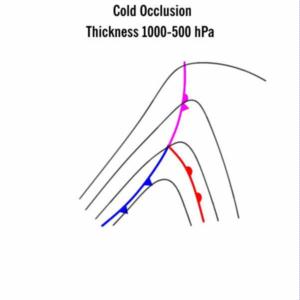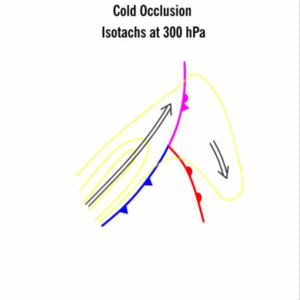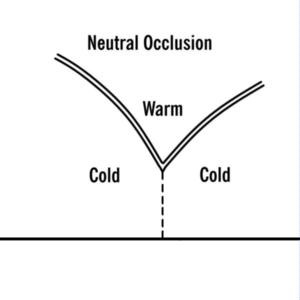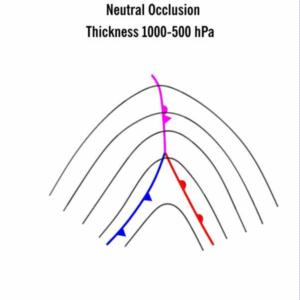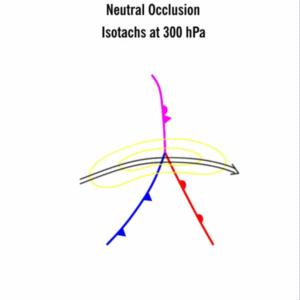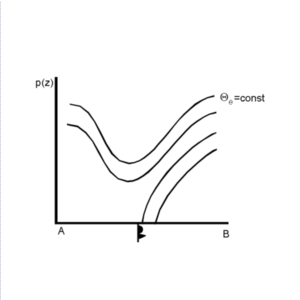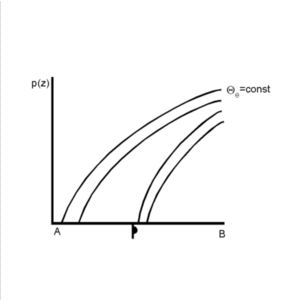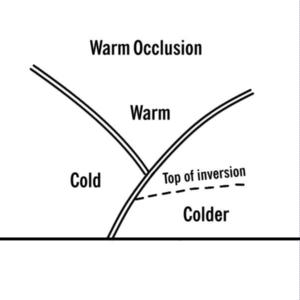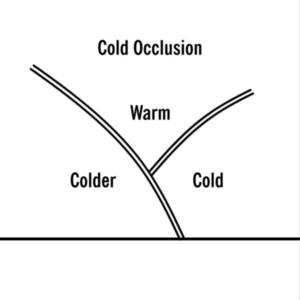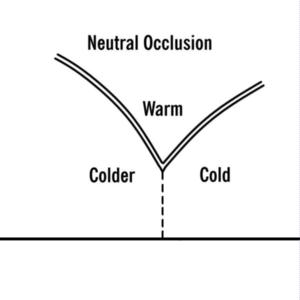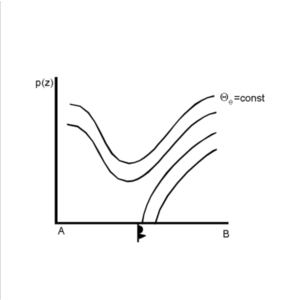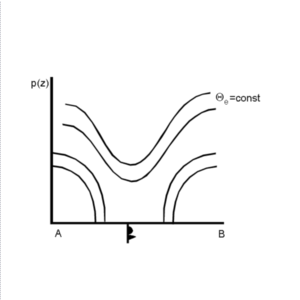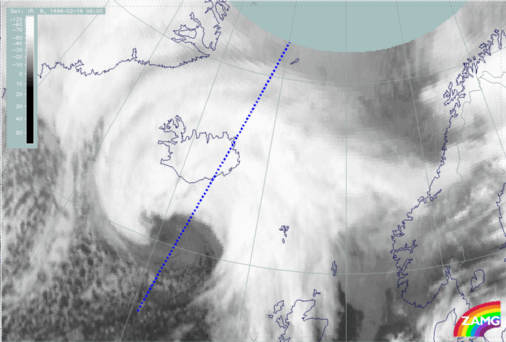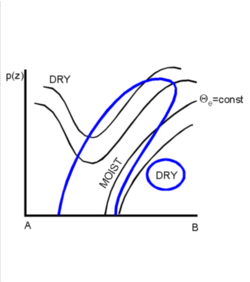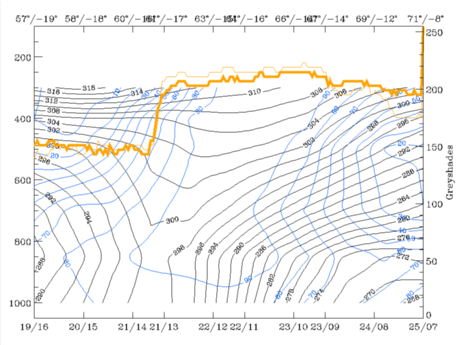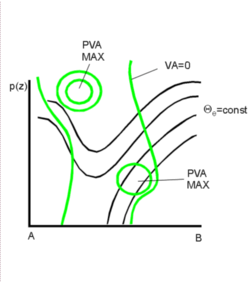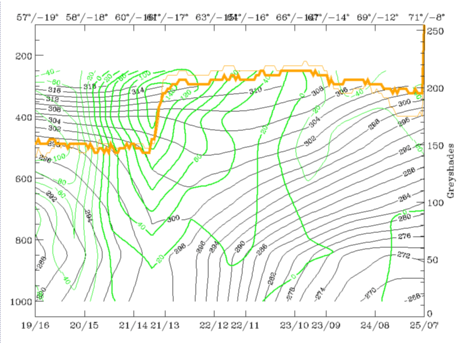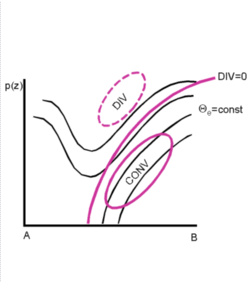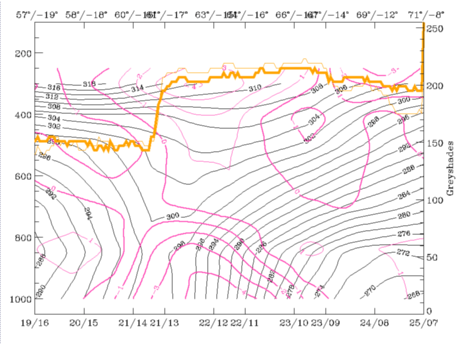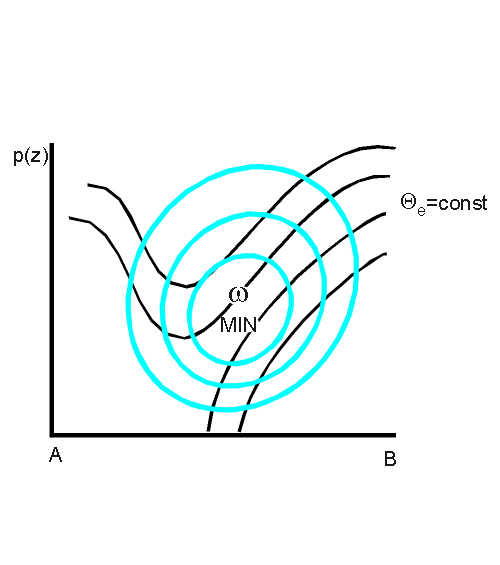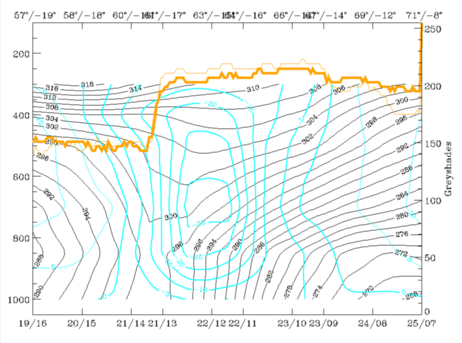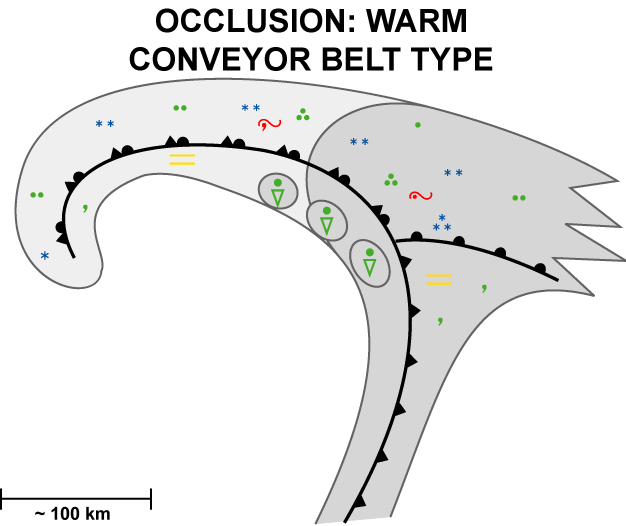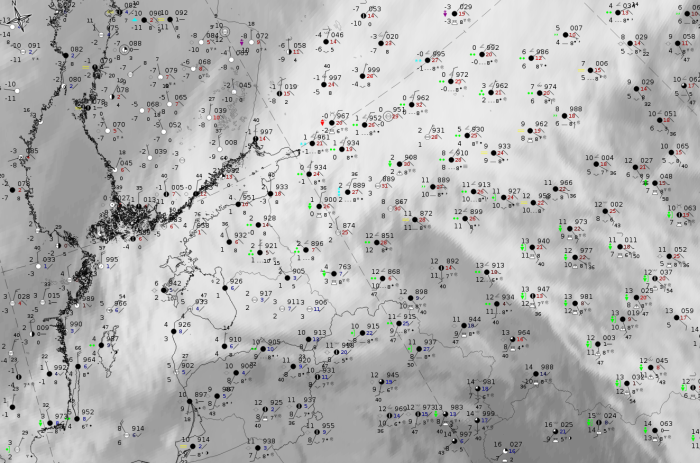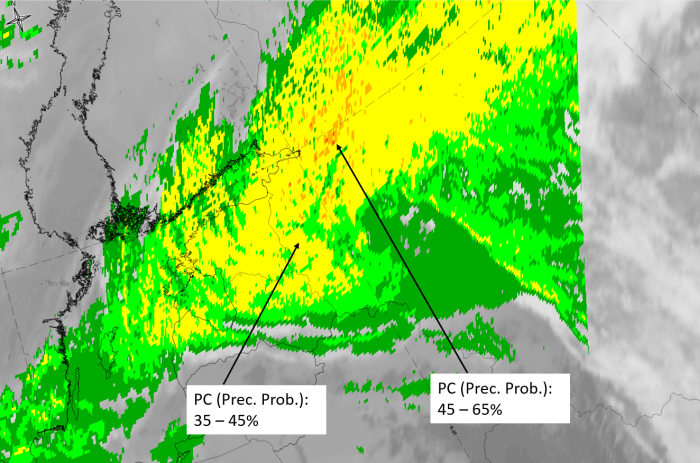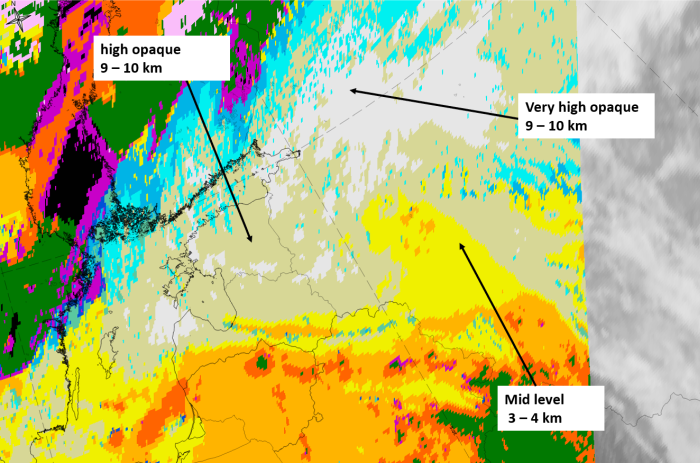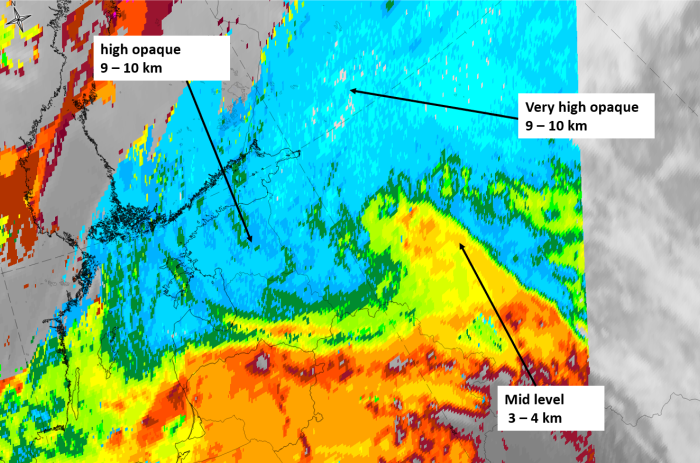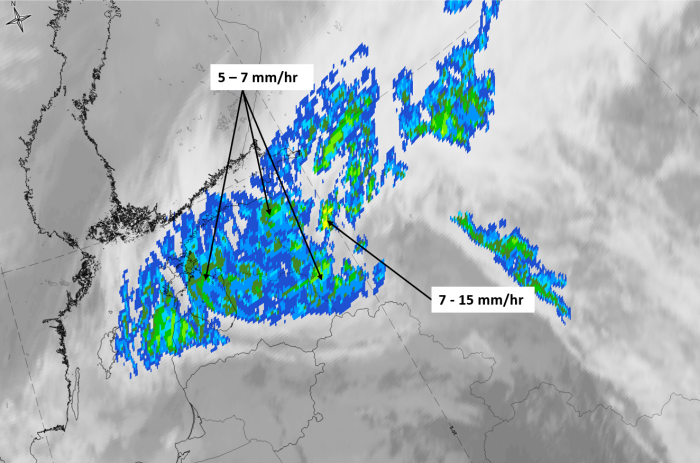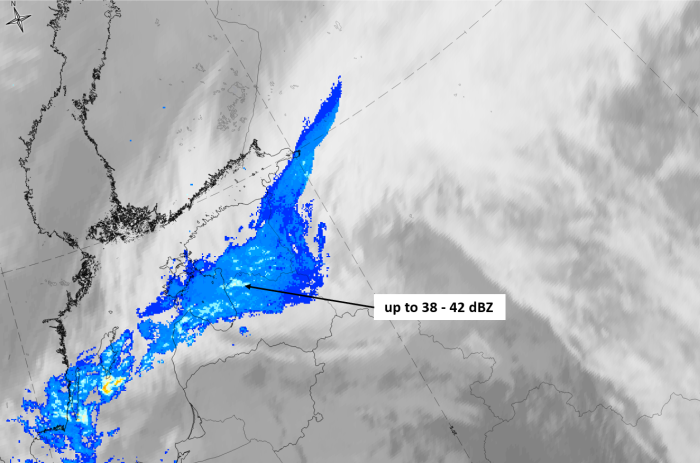Table of Contents
Cloud Structure In Satellite Images
As already mentioned in the general remarks, the cloud band of the occlusion described in this chapter is the result of a classical wave development (see Wave) represented by a growing multilayered cloud spiral.
Appearance in the basic channels:
At the fully developed stage the following points can be summarized:
- The IR, WV and VIS images show a cyclonically-curved synoptic-scale cloud spiral, which originates from its genesis connected with the cloud band of the cold and the warm front.
- In the VIS image the cloud spiral is white indicating cloudiness with high albedo.
- In the IR image the grey shades can vary between grey and white with the brightest cloud tops in the transitional area between the cloud band of the cold front and the occlusion, where the point of occlusion can be found. Often, grey shades become continuously darker downstream towards the centre of the spiral. This is due to the already descending conveyor belts within the mid- and upper levels of the troposphere (see Meteorological physical background). In most cases the cloud tops within the cloud spiral are characterised by a structured appearance.
- The WV image is characterised by high pixel values (white) within the frontal cloudiness. The rear cloud edge of the cloud spiral is characterised by a sharp gradient from white to black, caused by dry descending air within the relative stream of the dry intrusion (see Meteorological physical background).
- Convective cells and even Cb clouds may be embedded within rearward cloud edge of the cloud spiral. This is a preferred area for Cb development, because of a potentially unstable stratification of the troposphere caused by the different relative streams (see Meteorological physical background and Weather events).
Appearance in the basic RGBs:
Airmass RGB
At the rear of the occlusion spiral there are dark blue and brown colours representing the cold and dry air. Immediately at the rearward side of the CF cloud band, as well as in the centre of the cloud spiral, the brown stripe is usually very intense in colour.
The cloud band and spiral looks very similar to the IR images but in the innermost part pf the spiral a brown shade region can be overlaid, which represents overflowing cold and dry air.
Dust RGB
The Dust RGB shows pinkish-blue colours - representing a cloud free region. Frequently there are low cloud patches, as well as cold air cloud cells, which show up in yellow-brown colours.
The cloud spiral in case of a WCB occlusion shows dark-red and structures colours according to the convective character of the thick ice cloudiness.
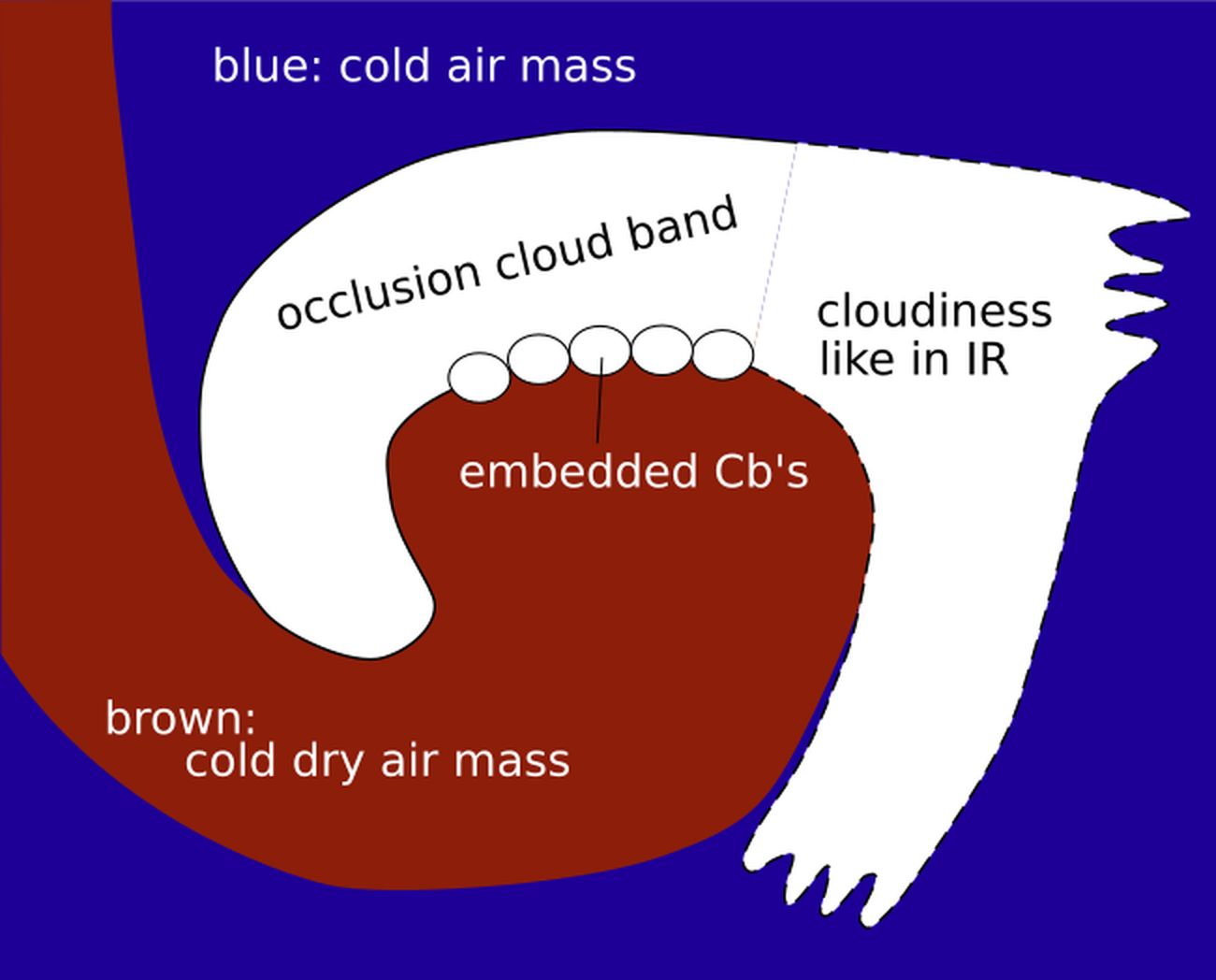 |
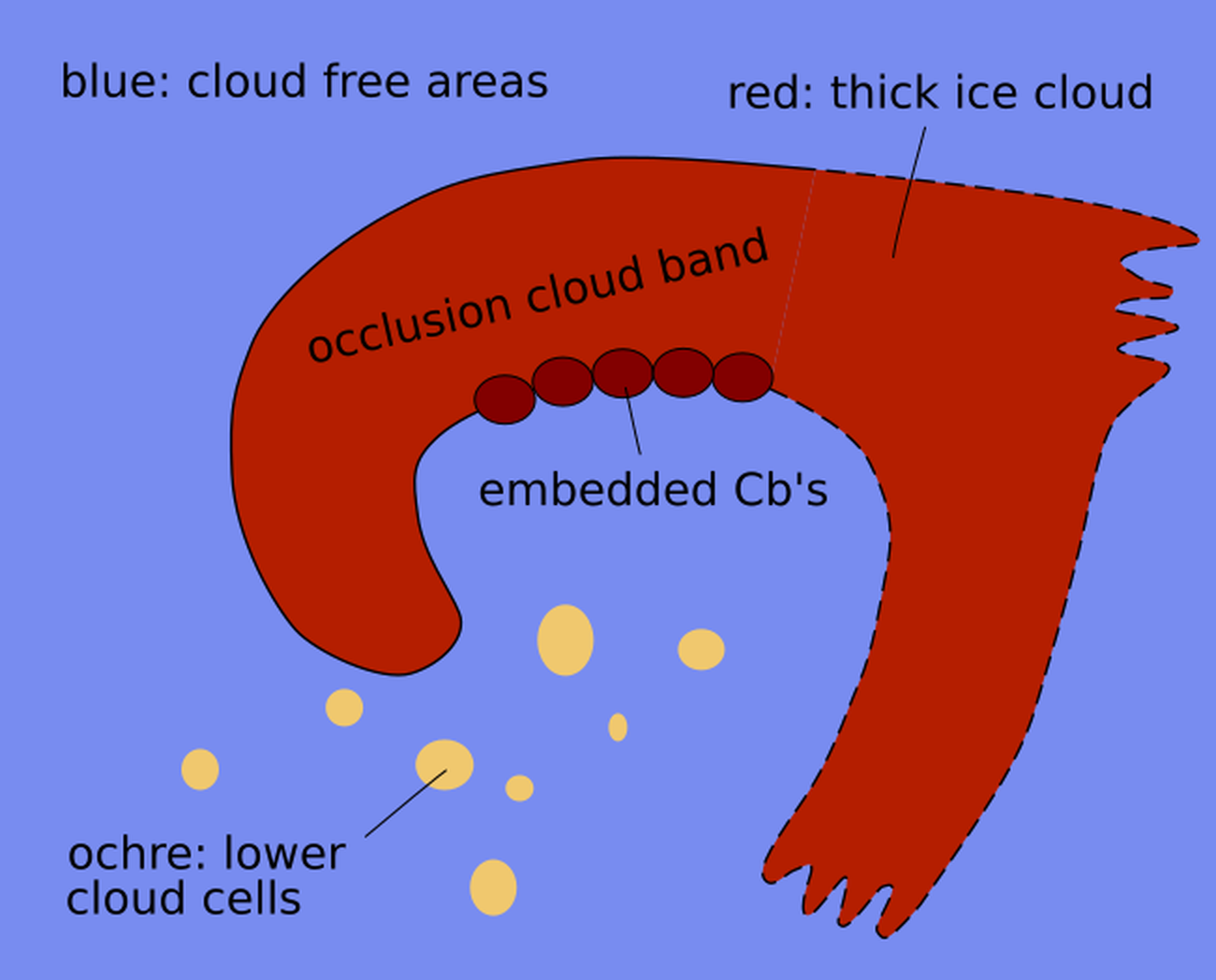 |
Legend: schematics for basic RGBs, Left: airmass RGB; right: dust RGB
The case from 5 November 2019 shows that between 00 and 15 UTC, a development from a wave stage over Lithuania and Belarus transitioned to a fully developed occlusion spiral extending from Russia across the Baltic States into the Baltic Sea.
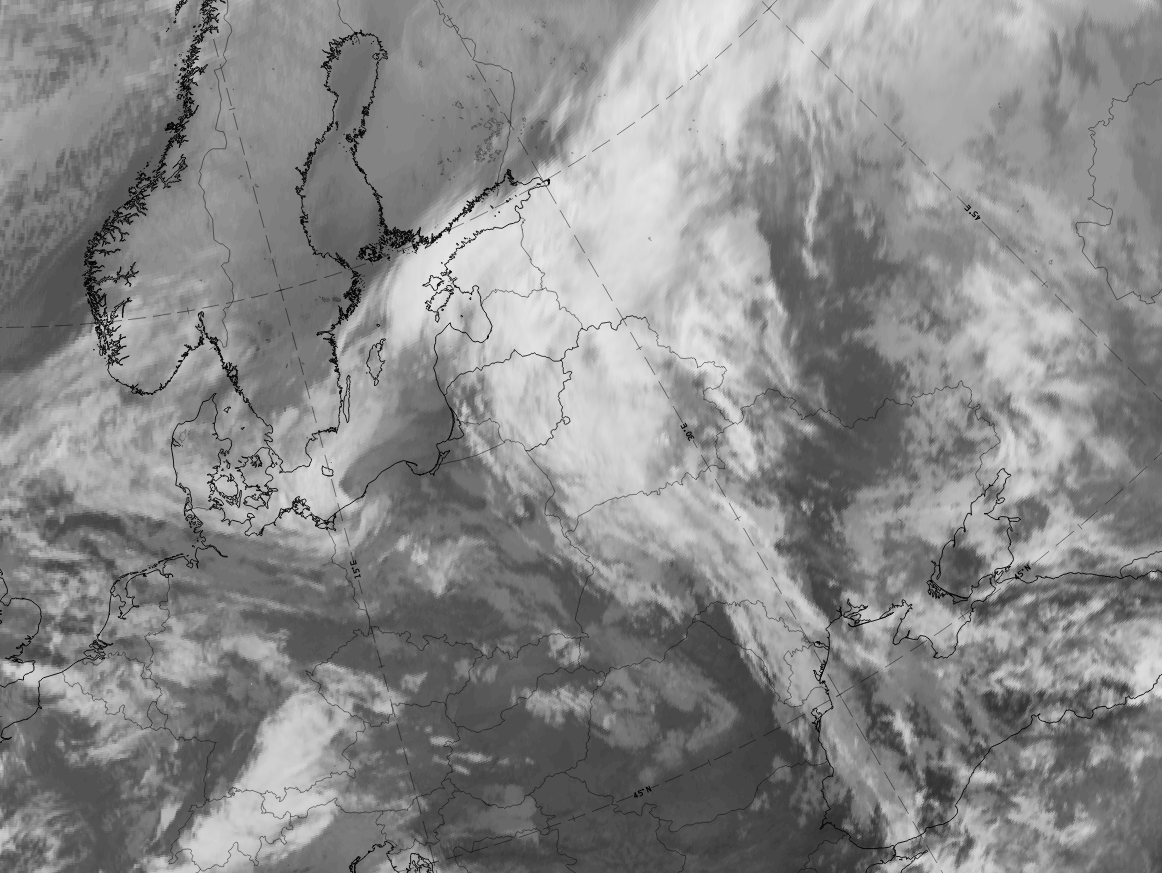 |
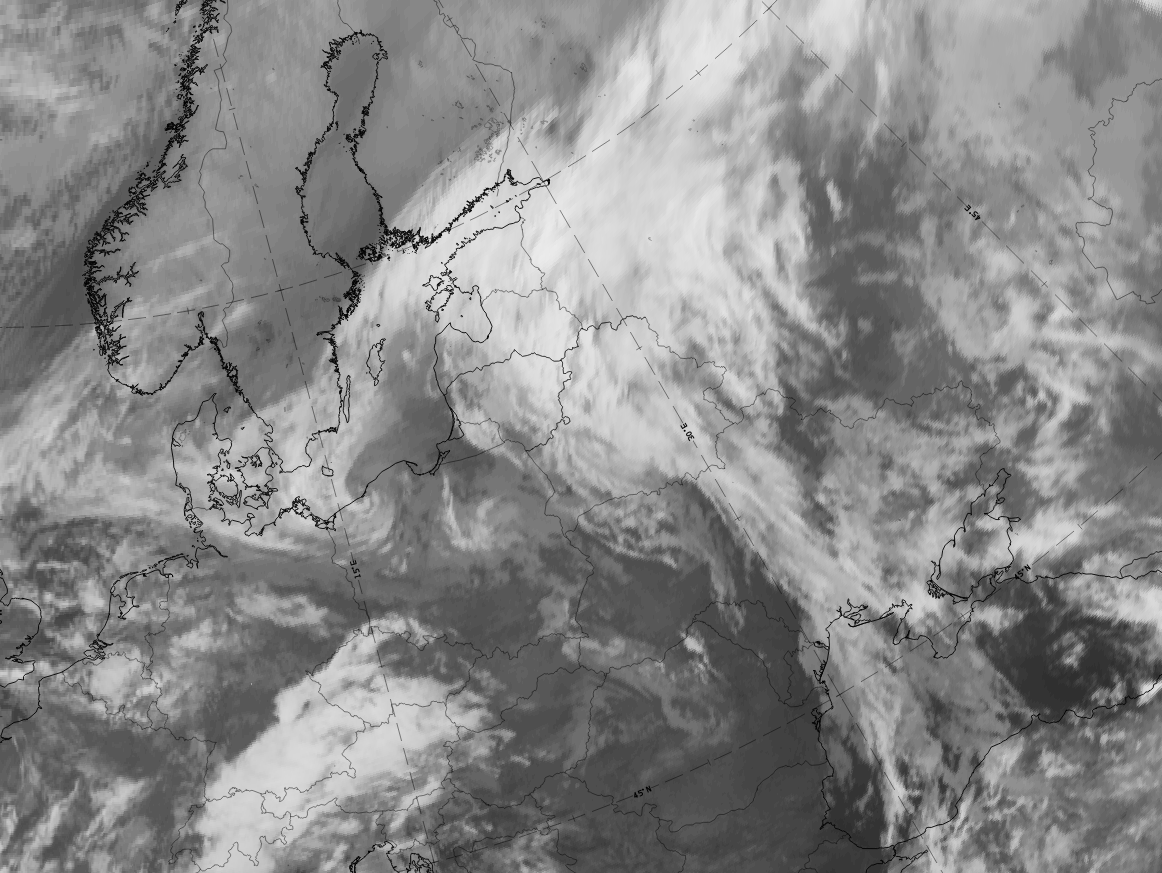 |
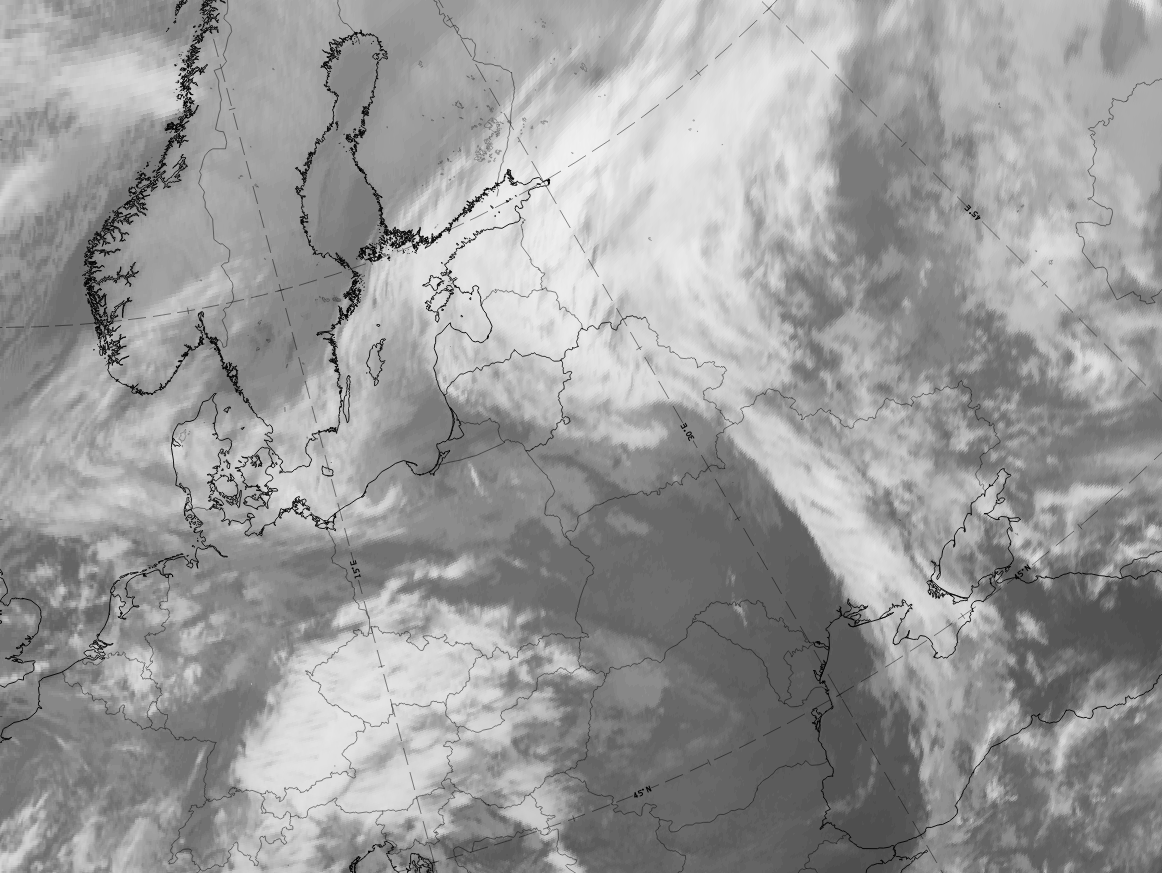 |
 |
 |
 |
Legend: 5 November 2019, IR images, 3 hourly from 00 to 15 UTC.
*Note: click on the image to access the image gallery (navigate using arrows on keyboard)
The fully developed stage of a warm conveyor belt (WCB) occlusion can be seen in all basic channels and RGBs at 5 November 2019 at 12 UTC.
|
|
|
|
5 November 2019/12UTC: 1st row: IR (above) + HRV (below); 2nd row: WV (above) + Airmass RGB (below); 3rd row: Dust RGB + image gallery.
*Note: click on the Dust RGB image to access image gallery (navigate using arrows on keyboard)
| IR | Bright and structured clouds; cellular pattern at the inner part of the cloud spiral. |
| HRV | Bright and structured clouds; cellular pattern at the inner part of the cloud spiral. |
| WV | Bright and structured clouds; black stripe along the rear edge of the CF and within the inside of the spiral. |
| Airmass RGB | The WCB cloud spiral is similar to the IR image; a dark brown stripe at the rear of the CF cloud band corresponds to the black stripe in WV. |
| Dust RGB | Dark red coloured structures indicate thick ice cloud. |
Meteorological Physical Background
The classical Norwegian model
The classical development of an Occlusion (Warm conveyor Belt Type) is described in the well-known Polar Front theory after Bergeron, Bjerknes and Solberg with a development sequence from a Wave Stage to an Occlusion Stage.
According to this classical theory of the Occlusion cloud band, this front separates the cold air mass, which is situated in front of the former Warm Front, from that behind the former Cold Front with a tongue of warm air within the higher levels of the troposphere (see Typical appearance in vertical cross section). Following the distribution of the temperature in front of and behind the Occlusion, three sub-types can be separated:
- If the air situated in front of the Warm Front has about the same temperature as the air situated behind, the temperature gradient dissolves during the process of the Occlusion. In this case the Occlusion is characterized only by a line of cyclonic shear and convergence which can be found vertically below the merging point of both fronts
- If the air situated in front of the Warm Front is colder than the air behind, a so-called Warm Front Occlusion develops which has a forward inclined frontal surface
- If the air situated in front of the Warm Front is warmer than the air behind, a so-called Cold Front Occlusion develops which has a backward inclined frontal surface
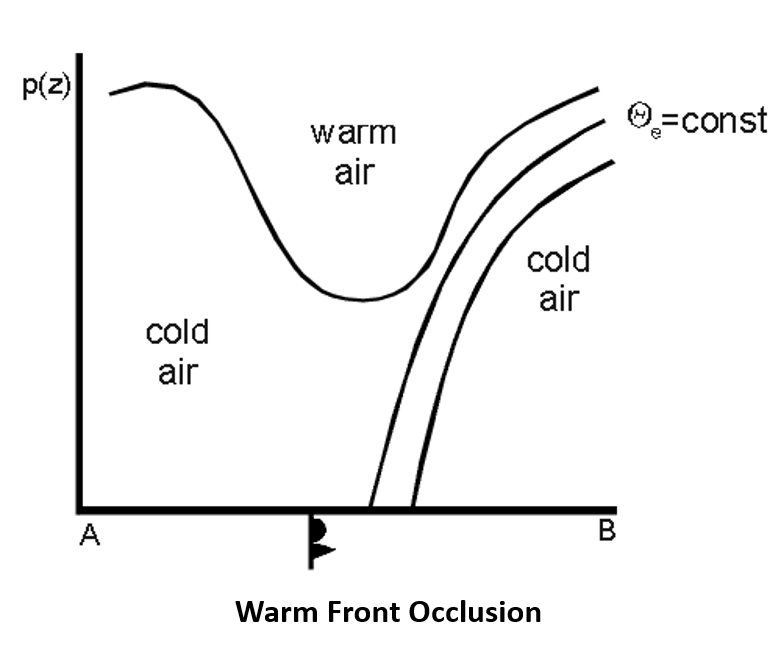 |
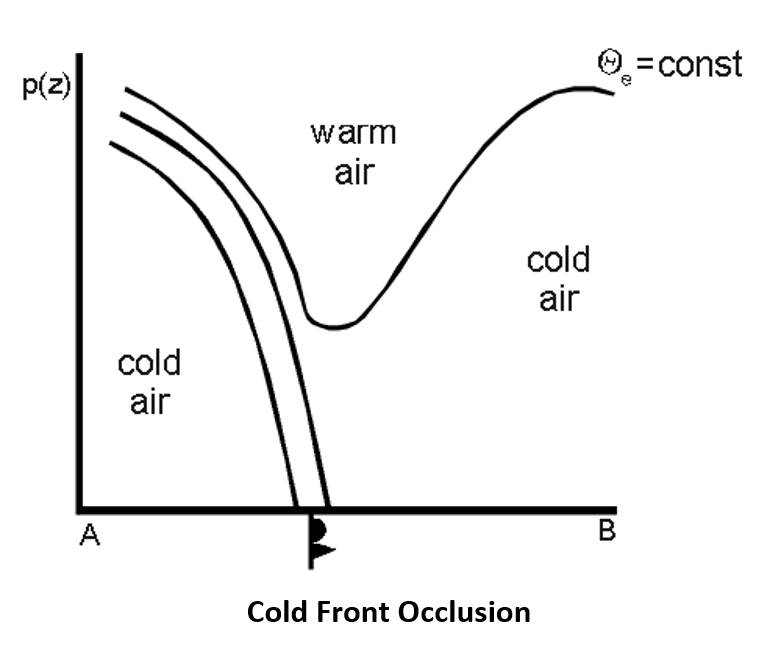 |
Deviations between cloud configurations in satellite images and the classical Norwegian model
Very soon after the use and study of satellite images it became clear that this idealized theory cannot be observed in every step and detail in reality. In particular, the overtaking of the Warm Front by the Cold Front with very narrow warm sectors can never be seen in the early development stages (left schematic). Instead of this a merging of Cold and Warm Front cloudiness in the centre of the surface low takes place followed by a westward extension of the Occlusion cloud spiral, while the Warm Front cloudiness becomes shorter (right schematic).
 |
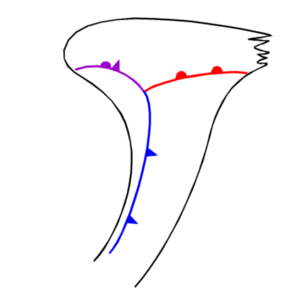 |
Beside this there are Occlusion spirals which contradict the overtaking mechanism completely. Those developments show a lower cloud spiral penetrating westward from below the Cold Front and Warm Front.
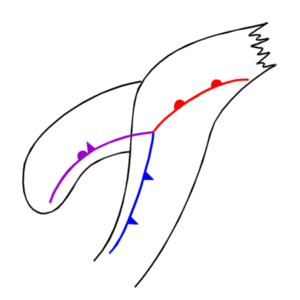
This type of occlusion cloud bands can much better be explained with the conveyor belt model and is described as a different Conceptual Model (Cold Conveyor Belt Occlusion) in this Satellite Manual.
The Conveyor Belt Model
The structure and formation of the cloud spiral of the Warm Conveyor Belt Occlusion type can also be described with the conveyor belt theory (Link to the theory chapter in Basics) as follows.
The higher levels of the troposphere are characterized by two relative streams:
- The Warm Conveyor Belt
The configuration of the warm conveyor belt depends on the stage of development. In the early wave stage the warm conveyor belt ascends within the cloud band of the Cold and Warm Front where it turns anticyclonically parallel to the surface warm front (see Warm Front Band). During this type of Occlusion development, the warm conveyor belt develops to a ridge-like hook over the occlusion band and later on splits into two parts: the eastern branch follows the cloud band of the Warm Front while on the western branch follows the cloud spiral of the Occlusion. This is one main difference to the Cold Conveyor Belt Type Occlusion.
- The Dry Intrusion
The dry intrusion is accompanied by descending air originating from the upper levels of the troposphere and/or the lower levels of the stratosphere. The dry intrusion is approximately to the rear/inner cloud edge of the cloud spiral of the Occlusion. If at all it overruns only the inner boundary zones of the cloud band. These are the areas predestined for the development of Cb Cloudiness, which often can be observed in the images (see Cloud structure in satellite image) as well as in the synoptic weather reports (see Weather events). The following reasons for the convective development can be found:
- the air advected within the dry intrusion has lower values of relative humidity than the air within the occlusion cloud band; this leads to the development of a conditionally unstable stratification;
- a CVA maximum indicating moving curvature vorticity contributes to upward motion according to the omega equation. This upward motion in the potential unstable environment can cause strong convection.
The fact that the dry intrusion does not cross the Occlusion cloud band in this warm conveyor belt development type is another big difference from the Cold Conveyor Belt Type Occlusion
 |
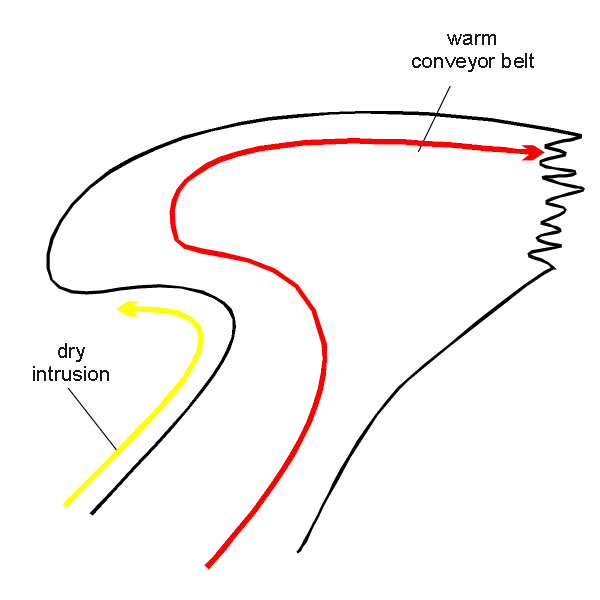 |
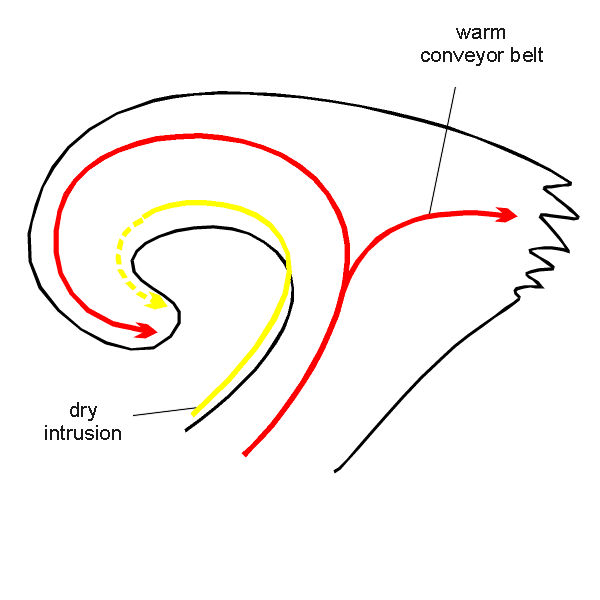 |
Because of the view from above on the cloud tops of the occlusion spiral in satellite images a third relative stream, which is involved in the process of a cyclogenesis is not visible in these stages of development.
The Cold Conveyor Belt which can be found parallel to the surface warm front below the Warm Conveyor Belt and is as such responsible for the lower layer of the cloudiness.
Discussion
A comprehensive study at ZAMG of many occlusion events over several years shows many of the mentioned points described above, but also some deviations. These facts can be summarized as follows:
- Classical Occlusion developments like the one described in this chapter occur rather seldom
- In most cases a cold conveyor belt with a lower cloud spiral could be observed
- Whether a Warm Conveyor Belt Occlusion type or a Cold Conveyor Belt Occlusion type develops seems to depend on the stage of development of the cyclone. If the height field in the mid- and upper levels of the troposphere displays a closed cyclonic circulation, the Warm Conveyor Belt Occlusion cloud spiral characterized by multilevel cloudiness is likely (see Key parameters). This is another difference between the two types of Occlusion (see Occlusion: Cold Conveyor Belt Type - Cloud structure in satellite image) and could be a tool for an early discrimination
- While the hook form of the warm conveyor belt in the beginning of the development can clearly be observed, appears the splitting into two branches in later stages not so clear and only during the transition of a Cold Conveyor Belt to a Warm Conveyor Belt Occlusion
|
21 October 1996/18.00 UTC - Vertical cross section; black: isentropes (ThetaE), blue: relative humidity, orange thin: IR pixel values, orange thick: WV pixel values
|
21 October 1996/18.00 UTC - Meteosat IR image; magenta: relative streams 305K - system velocity: 206° 13 m/s, yellow: isobars 305K, position of vertical cross section indicated
|
|
21 October 1996/18.00 UTC - Meteosat IR image; magenta: relative streams 310K - system velocity: 206° 13 m/s, yellow: isobars 310K, position of vertical cross section indicated
|
21 October 1996/18.00 UTC - Meteosat IR image; magenta: relative streams 320K - system velocity: 206° 13 m/s, yellow: isobars 320K, position of vertical cross section indicated
|
In the vertical cross section, which extends in the Atlantic from approximately 44N/28W to approximately 60N/25W, the isentropic surface of 310K is a surface within the occlusion cloud band. Both relative streams on this surface cut the cross section perpendicularly at about 650 hPa. This is an area of high humidity for the cold conveyor belt, but an area of high humidity gradient for the dry intrusion.
On the isentropic surface of 305K the cold conveyor belt can be observed within the cloud spiral.
A cold conveyor belt can still be observed on the isentropic surface of 310K but the innermost parts of the cloud spiral are already overrun by the dry intrusion.
On the isentropic surface of 320K the hook form of the upper relative stream accompanies a large part of the Occlusion cloudiness. For this the assumption has to be made that the zero line of shear vorticity does not cut the cloud band as computed by the numerical model, but follows the rear cloud edge and is connected to the western zero line of the shear vorticity.
Key Parameters
- Absolute topography at 500 and 1000 hPa:
The absolute topography at 1000 hPa is characterized by a low in the height field in the centre of the cloud spiral. In the initial stage the absolute topography at 500 hPa shows already a very pronounced upper level trough which very soon develops into a closed circulation. This is a main difference from the Occlusion of the Cold Conveyor Belt Type (see Occlusion: Cold Conveyor Belt Type - Key parameters ). - Equivalent thickness:
A prominent feature is the ridge of the equivalent thickness which is the consequence of the lifted warm air. In the case of well developed deep lows even a spiral structure of the ridge can be observed. But there are also situations which deviate from the distinct ridge structure. Well developed forms of Warm Front Occlusions and Cold Front Occlusions may lead to a more pronounced thickness gradient in the area of the Occlusion. This can be observed much better in the vertical cross section (see Typical appearance in vertical cross section). - Thermal front parameter (TFP):
The thermal front parameter mostly can be found close to the rear area of the cloud spiral. But the very existence of a front parameter depends on the existence of a pronounced temperature gradient. - Temperature advection:
The whole cloudiness of the Occlusion is under the influence of warm advection. The warm advection maximum can be found in the centre of the cloud spiral, mostly close to the point of the Occlusion. The zero line of the temperature advection follows the rearward edge of the Occlusion cloud spiral - Zero line of the shear vorticity at 300 hPa:
The zero line of the shear vorticity, which also indicates the jet axis, follows the edge of the cloud spiral. - Isotachs at 300 hPa:
As the jet stream does not cross the Occlusion cloud band, the isotachs show a minimum of wind speed in the area of the point of the Occlusion. Typically, two pronounced jet streaks can be found parallel to the rear cloud edge of the cold front as well as to the leading cloud edge of the Warm Front. - Vorticity advection at 500 hPa and 300 hPa:
The cloud spiral of the Occlusion is in general superimposed by PVA in the mid-levels of the troposphere. The maximum values can be found very close to the rear cloud edge (see Meteorological physical background and Weather events).
The case of 19 February 1998 shows a rather untypical upper level field with a small scale trough. The case of 21 October 1996 shows the more typical configuration.
|
19 February 1998/12.00 UTC - Meteosat IR image; magenta: height contours 1000 hPa, cyan: height contours 500 hPa
|
|
|
21 October 1996/12.00 UTC - Meteosat IR image; magenta: height contours 1000 hPa, cyan: height contours 500 hPa
|
Equivalent thickness and TFP
|
19 February 1998/12.00 UTC - Meteosat IR image; blue: thermal front parameter 500/850 hPa, green: equivalent thickness 500/850 hPa
|
|
Temperature Advection at 700 hPa
|
19 February 1998/12.00 UTC - Meteosat IR image; blue: thermal front parameter 500/850 hPa, red: warm advection 500/1000 hPa
|
|
Vorticity advection at 500 hPa
|
19 February 1998/12.00 UTC - Meteosat IR image; green: positive vorticity advection (PVA) 500 hPa
|
|
|
19 February 1998/12.00 UTC - Meteosat IR image; yellow: isotachs 300 hPa, black: zero line of shear vorticity 300 hPa, red: positive vorticity advection (PVA) 300 hPa
|
|
Zero line of the shear vorticity at 300 hPa
|
19 February 1998/12.00 UTC - Meteosat IR image; blue: shear vorticity 300 hPa, brown: curvature vorticity 300 hPa
|
|
In literature several sub-types of Occlusions according to the Norwegian model can be found. They refer to mature development stages and their discrimination cannot be based on cloudiness in satellite imagery but on useful numerical key parameters. The following summary of such sub-types ismainly based on work carried out at the Finnish Meteorological Service (FMI).
Warm Occlusion Type
Warm Occlusion types are characterized by a Warm Front - like crowding zone of isentropes in low layers. They are typical for western Europe and Scandinavia especially in winter.
The temperature gradient is strongest in front of the Warm Front and the Occlusion.
The thickness gradient is stronger in front of the Warm Front and the Occlusion.
The jet stream is weakening over the Occlusion and there is a uniform jet stream in front of the Warm Front and the Occlusion.
Cold Occlusion Type
Cold Occlusion types are characterized by a Cold Front like crowding zone of isentropes in low layers. They occur mainly in the eastern parts of large continents such as North America and Asia, especially during cold seasons. In Europe Cold Occlusions often can occur during warm seasons when colder air propagates from sea over warm continent.
The temperature gradient is strongest in the rear of the Cold Front and the Occlusion.
The thickness gradient is stronger in the rear of the Cold Front and the Occlusion.
The jet stream is weakening over the Occlusion. A separate weaker jet stream is only in front of the warm front. The jet stream in connection with the Cold Front turns in the rear of the Occlusion towards the cyclone centre.
Neutral Occlusion Type
Neutral Occlusions are only upper level features. They are not so common.
The temperature gradient is equal on both sides of the Occlusion.
The thickness gradient is equal on both sides of the Occlusion.
The jet crosses the cloud band at the Occlusion point.
Typical Appearance In Vertical Cross Sections
No notable difference could be found in the configuration of NWP parameters within vertical cross sections between Warm Conveyor Belt Occlusion and Cold Conveyor Belt Type.
The isentropes of the equivalent potential temperature generally show a distinct trough structure indicating the warmer air which has been lifted (see Meteorological physical background) and the crowding zone of a surface front. In this case the upper level trough is forward inclined with height. The most frequent configuration is a Warm Front inclined crowding zone in front of the isentropic trough structure. The difference between the cross section of an Occlusion cloud band and of a Warm Front cloud band can be seen in the layer above the Warm Front surface: in a Warm Front case the isentropic trough configuration does not exist (see Warm Front Band, Warm Front Shield and Detached Warm Front).
According to the sub-types Warm Occlusion Type, Cold Occlusion Type and Neutral Occlusion Type (see key parameters) the following three vertical distributions of frontal zones can be expected.
In the investigation carried out by ZAMG two main different configurations could be observed:
- A Warm Front type: in this case the isentropic trough is forward inclined on top of the Warm Front zone.
- A Warm Front inclined crowding zone in front and a Cold Front inclined crowding zone behind the isentropic trough feature. In this case the forward inclination of the isentropic trough is not as strongly pronounced as in the other case. Sometimes also a straight vertical trough axis can be observed.
The field of the relative humidity is characterized by high values, of about 80% and even more, within the area of the isentropic trough. In the case of a forward inclined trough the maximum values of the humidity have forward inclination; two low values of relative humidity can be observed within and below the lower isentropes of the Warm Front - like crowding zone. This minimum typically is situated between approximately 800 and 700 hPa. A second minimum of relative humidity can be found on the rear side of the isentropic trough within the upper levels of the troposphere at approximately 300 hPa. This corresponds to the following dry intrusion.
The whole area of the Warm Front inclined crowding zone and the leading part of the isentropic trough feature is under the influence of pronounced WA. The maximum of WA mostly can be found within the lower levels of the troposphere very close to the area where the Warm Front inclined crowding zone reaches the surface. A secondary pronounced area of WA can be found within the upper levels of the troposphere on the rear side of the isentropic trough. This area is typically situated at approximately 300 hPa and indicates the tropopause. The lower and mid-levels of the troposphere are characterized by pronounced CA. The zero line of temperature advection is close to the minimum of the isentropic trough in the lower and mid-levels of the troposphere. Very often the zero line in these levels is characterized by a forward inclination which leads to the development of a potentially unstable stratification of the troposphere (see Meteorological physical background and Key parameters).
The field of vorticity advection is characterized by PVA within the whole area of the Occlusion. Typically two PVA maxima can be found in the cross section. The main maximum exists in the upper levels of the troposphere on the rear side of the isentropic trough and is connected with the left exit region of a jet streak; a weaker PVA maximum exists within the Warm Front inclined crowding zone in the lower levels of the troposphere at approximately 800 hPa. This maximum is connected with the already pronounced cyclonic circulation in these levels and indicates the propagation of the low area (see Meteorological physical background and Key parameters).
The field of divergence shows pronounced convergence within the area of the Warm Front inclined crowding zone and within the lower part of the leading area of the isentropic trough configuration. In the upper part divergence prevails. The zero line of divergence can be found very close to the trough axis.
According to the distribution of convergence, temperature advection and vorticity advection, the field of vertical motion (omega) shows a wide area of strong upward motion within the area of the occlusion. The strongest upward motion typically can be found within the mid-levels of the troposphere.
The pixel values of the satellite images in IR, VIS and WV are characterized by high values within the cloud band indicating multilevel cloudiness. The rear cloud edge in the WV image often is characterized by a sharp gradient due to the dry air which is advected within the relative stream of the dry intrusion (see Cloud structure in satellite image and Meteorological physical background).
|
19 February 1998/06.00 UTC - Meteosat IR image; position of vertical cross section indicated
|
|
|
19 February 1998/06.00 UTC - Vertical cross section; black: isentropes (ThetaE), blue: relative humidity, orange thin: IR pixel values, orange thick: WV pixel values
|
|
|
19 February 1998/06.00 UTC - Vertical cross section; black: isentropes (ThetaE), red thick: temperature advection - WA, red thin: temperature advection - CA, orange thin: IR pixel values, orange thick: WV pixel values
|
|
|
19 February 1998/06.00 UTC - Vertical cross section; black: isentropes (ThetaE), green thick: vorticity advection - PVA, green thin: vorticity advection - NVA, orange thin: IR pixel values, orange thick: WV pixel values
|
|
|
19 February 1998/06.00 UTC - Vertical cross section; black: isentropes (ThetaE), magenta thin: divergence, magenta thick: convergence, orange thin: IR pixel values, orange thick: WV pixel values
|
|
|
19 February 1998/06.00 UTC - Vertical cross section; black: isentropes (ThetaE), cyan thick: vertical motion (omega) - upward motion, cyan thin: vertical motion (omega) - downward motion, orange thin: IR pixel values, orange thick: WV pixel values
|
|
The cross section shows a Warm Front inclined crowding zone in the leading area and a Cold Front inclined crowding zone at the rear of the Occlusion. In the mid- and upper levels of the troposphere between the surface fronts a forward inclined isentropic trough can be observed. Forward inclined high values of humidity can be found within the leading part of the trough. The humidity minimum appears, representing the dry intrusion, behind the area of the rear cloud edge at approximately 300 hPa. The second humidity minimum mentioned above is not well developed in this case. Some indication can be found within the area of the Warm Front inclined crowding zone at approximately 700 hPa. The field of temperature advection shows strong WA within the leading part and strong CA within the rear part of the Occlusion. The zero line within the lower and mid-levels of the troposphere has a forward inclination which leads to the development of a potentially unstable stratification of the troposphere around 61N/17W. The field of vorticity advection contains both PVA maxima mentioned above: a PVA maximum at approximately 300 hPa at the rearward edge of the cloud band and the typical PVA maximum within the lower levels at approximately 800 hPa (at approximately 64N/16W). The field of divergence shows convergence within the lower and divergence within the upper levels of the troposphere. The field of omega shows strong upward motion within the whole area of the Occlusion.
Weather Events
| Parameter | Description |
| Precipitation |
|
| Temperature |
|
| Wind (incl. gusts) |
|
| Other relevant information |
|
|
|
Legend:
5 November 2019 at 12UTC: IR + synoptic measurements (above) + probability of moderate rain (Precipitting clouds PC - NWCSAF).
Note: for a larger SYNOP image click this link.
The cloud band of the WCB occlusion shows wide spread precipitation, Cb and shower reports from synoptic measurements. The probability of moderate rain from the NWCSAF analysis is widespread - up to 45 % (which can, according to the NWCSAF analyses evaluations, already be connected with precipitation). Smaller areas and spots with higher analysis probabilities are connected to corresponding Cb and even to thunderstorm reports.
|
|
|
|
5 November 2019 at 12 UTC
1st row: Cloud Type (CT NWCSAF) (above) + Cloud Top Height (CTTH - NWCSAF) (below); 2nd row: Convective Rainfall Rate (CRR NWCSAF) (above) + Radar intensities from Opera radar system (east part lies outside of the Opera area) (below).
For identifying values for Cloud type (CT), Cloud type height (CTTH), precipitating clouds (PC), and Opera radar for any pixel in the images look into the legends. (link).
References
General Meteorology and Basics
- BENNETTS D. A., GRANT J. R. and MCCALLUM E. (1988): An introductory review of fronts. Part I: Theory and observations; Met. Mag., Vol. 117, p. 357 - 370
- BENNETTS D. A., GRANT J. R. and MCCALLUM E. (1989): An introductory review of fronts. Part II: A case study; Met. Mag., Vol. 118, p. 8 - 12
- BOHR P., KATHE G., KNORR M., KURZ M. and LANGE K. - D. (1987): Allgemeine Meteorologie - Leitfäden für die Ausbildung im Deutschen Wetterdienst, 3. Auflage, Selbstverlag des Deutschen Wetterdienstes
- BROWNING K. A. (1985): Conceptual models of precipitation systems; Met. Mag., Vol. 114, p. 293 - 317
- BROWNING K. A. (1986): Conceptual models of precipitation systems; Weather&Forecasting, Vol. 1, p. 23 - 41
- CONWAY B. J., GERARD L., LABROUSSE J., LILJAS E., SENESI S., SUNDE J. and ZWATZ-MEISE V. (1996): COST78 Meteorology - Nowcasting, a survey of current knowledge, techniques and practice; Phase 1 report; Office for official publications of the European Communities
- GREEN J. S. A., LUDLAM F. H. and MCILVEEN J. F. R. (1966): Isentropic relative - flow analysis and the parcel theory; Quart. J. R. Meteor. Soc., Vol. 92, p. 210 - 219
- HARROLD T. W. (1973): Mechanisms influencing the distribution of precipitation within baroclinic disturbances; Quart. J. R. Meteor. Soc., Vol. 99, p. 232 - 251
- KURZ M. (1990): Synoptische Meteorologie - Leitfäden für die Ausbildung im Deutschen Wetterdienst; 2. Auflage, Selbstverlag des Deutschen Wetterdienstes
- LILJEQUIST G. H. and CEHAK K. K. (1984): Allgemeine Meterorologie, 3. Auflage, Braunschweig Vieweg
General Satellite Meteorology
- BADER M. J., FORBES G. S., GRANT J. R., LILLEY R. B. E. and WATERS A. J. (1995): Images in weather forecasting - A practical guide for interpreting satellite and radar imagery; Cambridge University Press
Specific Satellite Meteorology
- BROWNING K. A. and HILL F. F. (1985): Mesoscale analysis of a polar trough interacting with a polar front; Quart. J. R. Meteor. Soc., Vol. 111, p. 445 - 462
- BROWNING K. A. (1990): Organization of clouds and precipitation in extratropical cyclones; in: Extratropical Cyclones, The Erik Palmen Memorial Volume, Ed. Chester Newton and Eero O Holopainen, p. 129 - 153
- CARLSON T. N. (1980): Airflow through mid-latitude cyclones and the comma cloud pattern; Mon. Wea. Rev., Vol. 108, p. 1498 - 1509
- CARLSON T. N. (1987): Cloud configuration in relation to relative isentropic motion; in: Satellite and radar imagery interpretation, preprints for a workshop on satellite and radar imagery interpretation - Meteorological Office College, Shinfield Park, Reading, Berkshire, England, 20 - 24 July 1987, p. 43 - 61
- EVANS M. S., KEYSER D., BOSART L. F. and LACKMANN G. M. (1994): A satellite derived classification scheme for rapid maritime cyclogenesis; Mon. Wea. Rev., Vol. 122, p. 1381 - 1416
- KREITZBERG C. W. and BROWN H. A. (1970): Mesoscale weather systems within an occlusion; J. Appl. Meteor., Vol. 9, p. 417 - 432
- MATEJKA T. J., HOUZE Jr. R. A. and HOBBS P. V. (1980): Microphysics and dynamics of clouds associated with mesoscale rainbands in extratropical cyclones; Quart. J. R. Meteor. Soc., Vol. 106, p. 29 - 56
- MULLEN S. L. (1983): Explosive cyclogenesis associated with cyclones in polar air streams; Mon. Wea. Rev., Vol. 111, p. 1537 - 1552
- PARSONS D. B. and HOBBS P. V. (1983): The mesoscale and microscale structure and organization of clouds and precipitation in mid-latitiude cyclones. Part XI: Comparison between observational and theoretical aspects of rainbands; J. Atmos. Sci., Vol. 40, p. 2377 - 2397
- REED R. J. (1990): Advances in knowledge and understanding of extratropical cyclones during the past quarter century: an overview; in Extratropical Cyclones, The Erik Palmen Memorial Volume, Ed. Chester Newton and Eero O Holopainen, p. 27 - 45
- THEPENIER R.-M. and CRUETTE D. (1981): Formation of cloud bands associated with the American subtropical jet stream and their interaction with mid-latitude synoptic disturbances reaching Europe; Mon. Wea. Rev., Vol. 109, p. 2209 - 2220
- WANG P-Y and HOBBS P. V. (1983): The mesoscale and microscale structure and organization of clouds and precipitation in mid-latitude cyclones. Part X: Wavelike rainbands in an occlusion; J. Atmos. Sci., Vol. 40, p. 1950 - 1964
